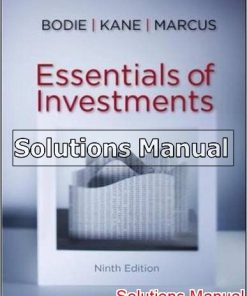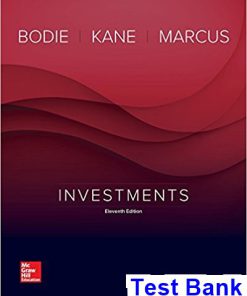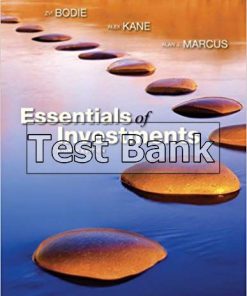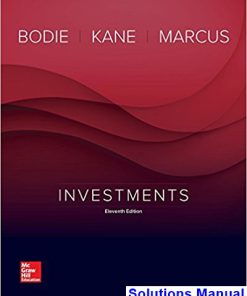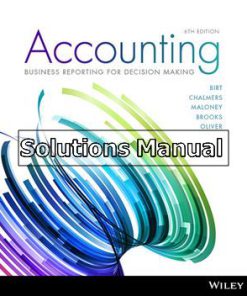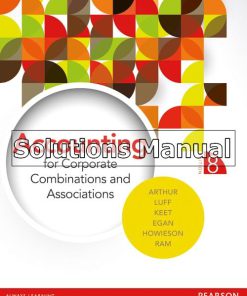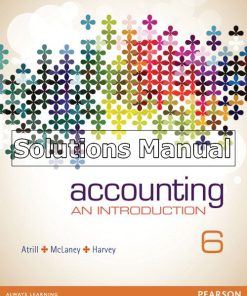Essentials of Investments 11th Edition Bodie Solutions Manual
You may also like
-
$26.50
$50.00 -
$26.50
$50.00
Essentials of Investments 11th Edition Bodie Solutions Manual

Product details:
- ISBN-10 : 1260013928
- ISBN-13 : 978-1260013924
- Author: Zvi Bodie
The market leading undergraduate investments textbook, Essentials of Investments by Bodie, Kane, and Marcus, emphasizes asset allocation while presenting the practical applications of investment theory. The authors have eliminated unnecessary mathematical detail and concentrate on the intuition and insights that will be useful to practitioners throughout their careers as new ideas and challenges emerge from the financial marketplace. The Eleventh Edition includes increased attention to changes in market structure and trading technology, while continuing to be organized around one basic theme – that security markets are nearly efficient.
Table contents:
Part ONE Elements of Investments 00 1 Investments: Background and Issues 00 1.1 Real Assets versus Financial Assets 00 1.2 A Taxonomy of Financial Assets 1.3 Financial Markets and the Economy The Informational Role of Financial Markets 00 Consumption Timing Allocation of Risk Separation of Ownership and Management Corporate Governance and Corporate Ethics 1.4 The Investment Process 1.5 Markets Are Competitive The Risk-Return Trade-Off Efficient Markets 1.6 The Players Financial Intermediaries Investment Bankers 1.7 Recent Trends Globalization Securitization Financial Engineering Computer Networks 1.8 Outline of the Text Summary 2 Asset Classes and Financial Instruments 2.1 The Money Market Treasury Bills Certificates of Deposit Commercial Paper Bankers? Acceptances Eurodollars Repos and Reverses Brokers? Calls Federal Funds The LIBOR Market Yields on Money Market Instruments 2.2 The Bond Market Treasury Notes and Bonds Inflation-Protected Treasury Bonds Federal Agency Debt International Bonds Municipal Bonds Corporate Bonds Mortgages and Mortgage-Backed Securities 2.3 Equity Securities Common Stock as Ownership Shares Characteristics of Common Stock Stock Market Listings Preferred Stock Depository Receipts 2.4 Stock and Bond Market Indexes Stock Market Indexes Dow Jones Averages Standard & Poor?s Indexes Other U.S. Market Value Indexes Equally Weighted Indexes Foreign and International Stock Market Indexes Bond Market Indicators 2.5 Derivative Markets Options Futures Contracts Summary 3 Securities Markets 3.1 How Firms Issue Securities Investment Banking Shelf Registration Private Placements Initial Public Offerings 3.2 How Securities Are Traded Types of Markets Types of Orders Trading Mechanisms 3.3 U.S. Securities Markets Nasdaq The New York Stock Exchange Electronic Communication Networks The National Market System Bond Trading 3.4 Market Structure in Other Countries London Euronext Tokyo Globalization and Consolidation of Stock Markets 3.5 Trading Costs 3.6 Buying on Margin 3.7 Short Sales 3.8 Regulation of Securities Markets Self-Regulation Regulatory Responses to Recent Scandals Circuit Breakers Insider Trading Summary 4 Mutual Funds and Other Investment Companies 4.1 Investment Companies 4.2 Types of Investment Companies Unit Investment Trusts Managed Investment Companies Other Investment Organizations 4.3 Mutual Funds Investment Policies How Funds Are Sold 4.4 Costs of Investing in Mutual Funds Fee Structure Fees and Mutual Fund Returns Late Trading and Market Timing Other Potential Reforms 4.5 Taxation of Mutual Fund Income 4.6 Exchange-Traded Funds 4.7 Mutual Fund Investment Performance: A First Look 4.8 Information on Mutual Funds Summary Part TWO Portfolio Theory 5 Risk and Return: Past and Prologue 5.1 Rates of Return Measuring Investment Returns over Multiple Periods Conventions for Quoting Rates of Return 5.2 Risk and Risk Premiums Scenario Analysis and Probability Distributions Risk Premiums and Risk Aversion The Sharpe (Reward-to-Volatility) Measure 5.3 The Historical Record Bills, Bonds, and Stocks, 1926?2006 5.4 Inflation and Real Rates of Return The Equilibrium Nominal Rate of Interest 5.5 Asset Allocation across Risky and Risk-Free Portfolios The Risky Asset The Risk-Free Asset Portfolio Expected Return and Risk The Capital Allocation Line Risk Tolerance and Asset Allocation 5.6 Passive Strategies and the Capital Market Line Historical Evidence on the Capital Market Line Costs and Benefits of Passive Investing Summary 6 Efficient Diversification 6.1 Diversification and Portfolio Risk 6.2 Asset Allocation with Two Risky Assets Covariance and Correlation Using Historical Data The Three Rules of Two-Risky-Assets Portfolios The Risk-Return Trade-Off with Two-Risky-Assets Portfolios The Mean-Variance Criterion 6.3 The Optimal Risky Portfolio with a Risk-Free Asset 6.4 Efficient Diversification with Many Risky Assets The Efficient Frontier of Risky Assets Choosing the Optimal Risky Portfolio The Preferred Complete Portfolio and the Separation Property 6.5 A Single-Factor Asset Market Specification of a Single-Index Model of Security Returns Statistical and Graphical Representation of the Single-Index Model Diversification in a Single-Factor Security Market 6.6 Risk of Long-Term Investments Are Stock Returns Less Risky in the Long Run? The Fly in the ?Time Diversification? Ointment (or More Accurately, the Snake Oil) Summary 7 Capital Asset Pricing and Arbitrage Pricing Theory 7.1 The Capital Asset Pricing Model Why All Investors Would Hold the Market Portfolio The Passive Strategy Is Efficient The Risk Premium of the Market Portfolio Expected Returns on Individual Securities The Security Market Line Applications of the CAPM 7.2 The CAPM and Index Models The Index Model, Realized Returns, and the Expected Return? Beta Relationship Estimating the Index Model Predicting Betas 7.3 The CAPM and the Real World 7.4 Multifactor Models and the CAPM The Fama-French Three-Factor Model Factor Models with Macroeconomic Variables Multifactor Models and the Validity of the CAPM 7.5 Factor Models and the Arbitrage Pricing Theory Well-Diversified Portfolios and Arbitrage Pricing Theory The APT and the CAPM Multifactor Generalization of the APT and CAPM Summary 8 The Efficient Market Hypothesis 8.1 Random Walks and the Efficient Market Hypothesis Competition as the Source of Efficiency Versions of the Efficient Market Hypothesis 8.2 Implications of the EMH Technical Analysis Fundamental Analysis Active versus Passive Portfolio Management The Role of Portfolio Management in an Efficient Market Resource Allocation 8.3 Are Markets Efficient? The Issues Weak-Form Tests: Patterns in Stock Returns Predictors of Broad Market Returns Semistrong Tests: Market Anomalies Strong-Form Tests: Inside Information Interpreting the Evidence The ?Noisy Market Hypothesis? and Fundamental Indexing 8.4 Mutual Fund and Analyst Performance Stock Market Analysts Mutual Fund Managers Survivorship Bias in Mutual Fund Studies So, Are Markets Efficient? Summary 9 Behavioral Finance and Technical Analysis 9.1 The Behavioral Critique Information Processing Behavioral Biases Limits to Arbitrage Limits to Arbitrage and the Law of One Price Bubbles and Behavioral Economics Evaluating the Behavioral Critique 9.2 Technical Analysis and Behavioral Finance Trends and Corrections Sentiment Indicators A Warning Summary Part THREE Debt Securities
People also search:
essentials of investments 11th edition
essentials of investments (11th edition pdf reddit)
essentials of investments answers
essentials of a good plan
essential or essentials


